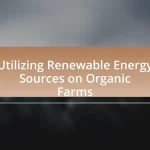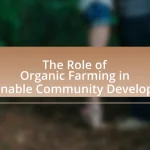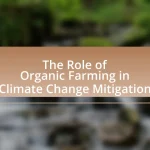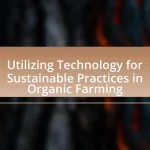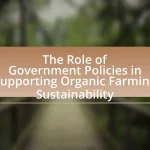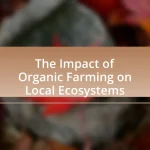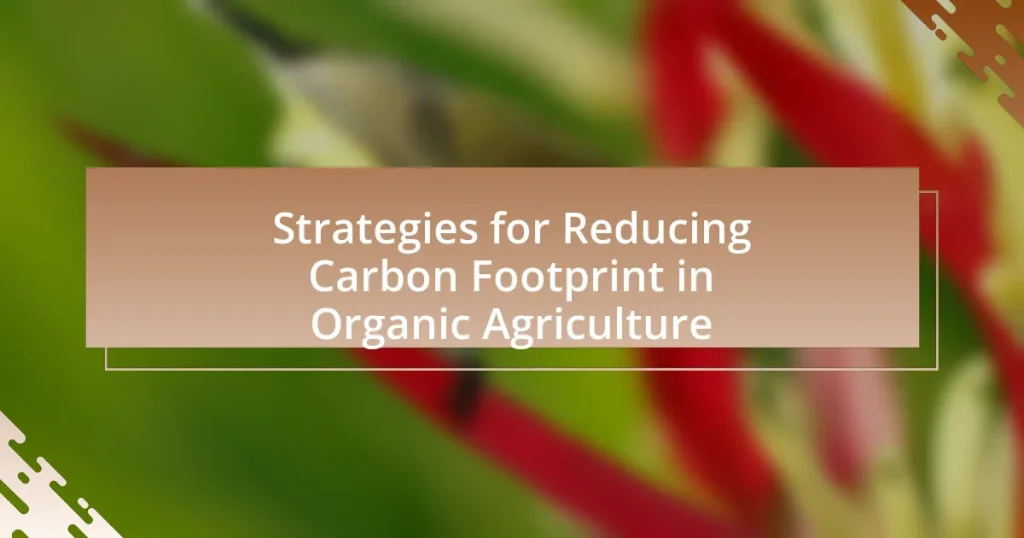The article focuses on strategies for reducing the carbon footprint in organic agriculture, emphasizing practices such as crop rotation, cover cropping, and reduced tillage. These methods enhance soil health, promote biodiversity, and minimize greenhouse gas emissions, contributing to overall sustainability in farming. The article also discusses the environmental benefits of carbon footprint reduction, the impact on consumer perception of organic products, and the challenges farmers face in adopting sustainable practices. Additionally, it highlights the role of technology and community initiatives in supporting organic farmers in their efforts to implement effective carbon-reducing strategies.

What are the key strategies for reducing carbon footprint in organic agriculture?
Key strategies for reducing carbon footprint in organic agriculture include implementing crop rotation, utilizing cover crops, enhancing soil health through composting, and optimizing resource use. Crop rotation helps break pest cycles and improves soil fertility, which can lead to reduced reliance on synthetic fertilizers. Cover crops prevent soil erosion and enhance carbon sequestration, contributing to lower greenhouse gas emissions. Composting enriches soil organic matter, promoting healthier ecosystems and reducing the need for chemical inputs. Additionally, optimizing resource use, such as water and energy, through precision agriculture techniques can significantly decrease carbon emissions associated with farming practices. These strategies collectively contribute to a more sustainable agricultural system with a lower carbon footprint.
How do these strategies impact overall sustainability?
Strategies for reducing carbon footprint in organic agriculture significantly enhance overall sustainability by minimizing greenhouse gas emissions and promoting ecological balance. These strategies, such as crop rotation, cover cropping, and reduced tillage, improve soil health and biodiversity, which are essential for sustainable farming practices. For instance, implementing cover crops can increase soil organic matter by up to 1.5 tons per hectare annually, leading to better carbon sequestration and improved soil fertility. Additionally, reduced tillage practices can decrease carbon emissions by approximately 25% compared to conventional tillage methods. Thus, these strategies not only lower carbon footprints but also contribute to long-term agricultural resilience and environmental health.
What specific practices contribute to lower carbon emissions?
Specific practices that contribute to lower carbon emissions in organic agriculture include crop rotation, cover cropping, reduced tillage, and integrated pest management. Crop rotation enhances soil health and reduces the need for synthetic fertilizers, which are carbon-intensive. Cover cropping prevents soil erosion and improves soil organic matter, leading to better carbon sequestration. Reduced tillage minimizes soil disturbance, preserving soil structure and reducing carbon release. Integrated pest management reduces reliance on chemical pesticides, lowering the carbon footprint associated with their production and application. These practices collectively contribute to a more sustainable agricultural system with lower greenhouse gas emissions.
How do these practices enhance soil health and biodiversity?
Practices such as cover cropping, crop rotation, and reduced tillage enhance soil health and biodiversity by improving soil structure, increasing organic matter, and promoting microbial diversity. Cover cropping prevents soil erosion and enhances nutrient cycling, while crop rotation disrupts pest and disease cycles, leading to healthier crops. Reduced tillage minimizes soil disturbance, preserving soil organisms and enhancing carbon sequestration. Research indicates that these practices can increase soil organic carbon levels by up to 30%, which supports a diverse ecosystem of soil organisms, thus fostering overall biodiversity.
Why is it important to focus on carbon footprint reduction in organic agriculture?
Focusing on carbon footprint reduction in organic agriculture is crucial because it directly contributes to mitigating climate change and enhancing sustainability. Organic farming practices, such as crop rotation and reduced synthetic inputs, can lower greenhouse gas emissions significantly. For instance, a study published in the journal “Agriculture, Ecosystems & Environment” found that organic farming can reduce carbon emissions by up to 40% compared to conventional methods. This reduction not only helps in preserving biodiversity but also improves soil health, leading to more resilient agricultural systems.
What are the environmental benefits of reducing carbon emissions?
Reducing carbon emissions leads to significant environmental benefits, including improved air quality and enhanced biodiversity. Lower carbon emissions decrease the concentration of greenhouse gases in the atmosphere, which mitigates climate change effects such as extreme weather events and rising sea levels. For instance, a study by the Intergovernmental Panel on Climate Change indicates that limiting global warming to 1.5 degrees Celsius could prevent up to 420 million people from experiencing severe heatwaves by 2050. Additionally, reducing emissions can lead to healthier ecosystems, as lower carbon levels contribute to cleaner air and water, promoting the survival of various plant and animal species.
How does carbon footprint reduction affect consumer perception of organic products?
Carbon footprint reduction positively influences consumer perception of organic products by enhancing their perceived value and sustainability. Consumers increasingly associate lower carbon emissions with higher environmental responsibility, leading to a preference for organic products that demonstrate commitment to sustainability practices. Research indicates that 66% of global consumers are willing to pay more for sustainable brands, highlighting the importance of carbon footprint reduction in shaping purchasing decisions. This trend is supported by studies showing that consumers perceive organic products as healthier and more environmentally friendly, reinforcing their choice to support brands that prioritize carbon reduction strategies.

What are the most effective methods for implementing these strategies?
The most effective methods for implementing strategies to reduce carbon footprint in organic agriculture include adopting agroecological practices, enhancing soil health, and utilizing renewable energy sources. Agroecological practices, such as crop rotation and intercropping, improve biodiversity and resilience, leading to lower emissions. Enhancing soil health through composting and cover cropping increases carbon sequestration, with studies showing that healthy soils can store up to 3.5 billion tons of carbon annually. Utilizing renewable energy sources, like solar and wind, reduces reliance on fossil fuels, contributing to a significant decrease in greenhouse gas emissions. These methods collectively support sustainable farming while effectively minimizing the carbon footprint.
How can farmers adopt sustainable practices in their operations?
Farmers can adopt sustainable practices in their operations by implementing crop rotation, cover cropping, and integrated pest management. Crop rotation enhances soil health and reduces pest and disease pressure, while cover cropping prevents soil erosion and improves nutrient cycling. Integrated pest management minimizes chemical use by combining biological, cultural, and mechanical control methods. According to the USDA, these practices can lead to a 30% reduction in greenhouse gas emissions, demonstrating their effectiveness in promoting sustainability in agriculture.
What role does crop rotation play in reducing carbon emissions?
Crop rotation plays a significant role in reducing carbon emissions by enhancing soil health and promoting biodiversity. This agricultural practice helps to improve soil structure and fertility, which can lead to increased carbon sequestration in the soil. Research indicates that diverse crop rotations can reduce the need for synthetic fertilizers, which are energy-intensive to produce and contribute to greenhouse gas emissions. For example, a study published in “Agriculture, Ecosystems & Environment” by Drinkwater et al. (2010) found that crop rotation systems can increase soil organic carbon levels by 10-20% compared to monoculture systems. This increase in soil carbon not only mitigates carbon emissions but also improves resilience against climate change impacts.
How can cover cropping contribute to carbon sequestration?
Cover cropping contributes to carbon sequestration by enhancing soil organic matter and promoting the uptake of atmospheric carbon dioxide through plant growth. When cover crops are planted, they capture carbon during photosynthesis and store it in their biomass and the soil as organic matter when they decompose. Research indicates that cover crops can increase soil organic carbon levels by 0.1 to 0.5 tons per hectare annually, depending on the species and management practices used. This process not only sequesters carbon but also improves soil health, water retention, and biodiversity, further supporting sustainable agricultural practices.
What technologies can assist in reducing carbon footprints?
Technologies that can assist in reducing carbon footprints include precision agriculture, renewable energy systems, and sustainable waste management practices. Precision agriculture utilizes data analytics and IoT devices to optimize resource use, which can lead to a reduction in greenhouse gas emissions; for instance, studies show that precision farming can reduce nitrogen fertilizer use by up to 30%, thereby lowering nitrous oxide emissions. Renewable energy systems, such as solar panels and wind turbines, provide clean energy alternatives that replace fossil fuels, significantly decreasing carbon emissions associated with energy consumption. Additionally, sustainable waste management technologies, like anaerobic digestion, convert organic waste into biogas, reducing methane emissions from landfills while producing renewable energy. These technologies collectively contribute to a more sustainable agricultural practice, aligning with the goals of reducing carbon footprints in organic agriculture.
How do precision agriculture tools help in minimizing resource use?
Precision agriculture tools minimize resource use by enabling targeted application of inputs such as water, fertilizers, and pesticides. These tools utilize data analytics, GPS technology, and sensors to assess field variability and optimize resource allocation. For instance, studies show that precision irrigation systems can reduce water usage by up to 30% while maintaining crop yields, demonstrating significant efficiency improvements. Additionally, precision nutrient management can decrease fertilizer application rates by 10-20%, reducing environmental impact and costs. This data-driven approach not only conserves resources but also enhances overall agricultural sustainability.
What innovations in organic farming are leading to lower emissions?
Innovations in organic farming that are leading to lower emissions include the use of cover cropping, agroforestry, and precision agriculture techniques. Cover cropping enhances soil health and reduces the need for synthetic fertilizers, which are significant sources of greenhouse gas emissions. Agroforestry integrates trees into agricultural landscapes, sequestering carbon and improving biodiversity. Precision agriculture employs technology to optimize resource use, minimizing waste and emissions associated with over-application of inputs. Research indicates that these practices can significantly reduce the carbon footprint of organic farming, with studies showing that cover cropping can reduce nitrogen oxide emissions by up to 50% and agroforestry can sequester an additional 1.1 to 2.6 billion tons of carbon dioxide annually.
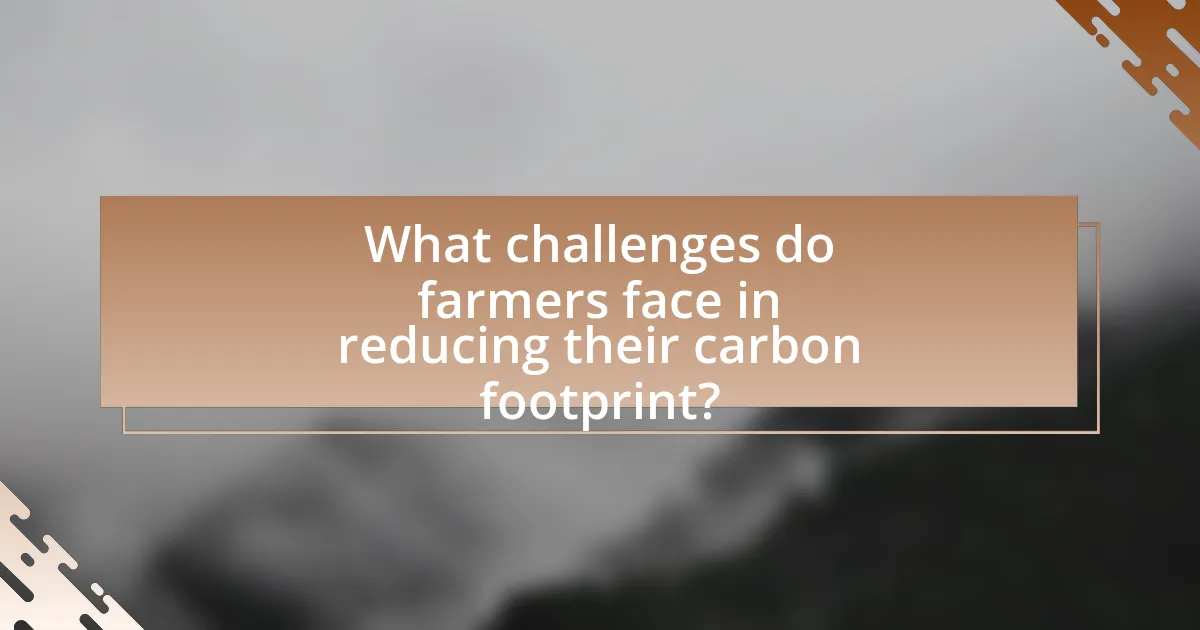
What challenges do farmers face in reducing their carbon footprint?
Farmers face several challenges in reducing their carbon footprint, primarily due to economic constraints, limited access to technology, and the need for education on sustainable practices. Economic constraints often prevent farmers from investing in more sustainable methods, as these can require upfront costs that may not yield immediate returns. Limited access to advanced agricultural technologies, such as precision farming tools that optimize resource use, further complicates efforts to lower emissions. Additionally, a lack of education and training on sustainable practices can hinder farmers’ ability to implement effective strategies for carbon reduction. According to a study published in the journal “Agricultural Systems,” farmers who received training on sustainable practices significantly improved their carbon management strategies, highlighting the importance of education in overcoming these challenges.
How can economic factors influence the adoption of sustainable practices?
Economic factors significantly influence the adoption of sustainable practices by affecting the cost-benefit analysis that individuals and organizations conduct when considering such practices. For instance, higher initial investments in sustainable technologies may deter adoption if the long-term savings are not perceived as sufficient. According to a study by the World Bank, financial incentives, such as subsidies or tax breaks, can enhance the economic viability of sustainable practices, leading to increased adoption rates among farmers. Additionally, market demand for sustainably produced goods can drive economic benefits, encouraging producers to adopt practices that reduce their carbon footprint. Thus, economic factors, including costs, incentives, and market demand, play a crucial role in determining the extent to which sustainable practices are embraced in organic agriculture.
What are the costs associated with transitioning to low-carbon methods?
The costs associated with transitioning to low-carbon methods in organic agriculture include initial investments in technology, training, and infrastructure. For instance, adopting renewable energy sources, such as solar panels or wind turbines, can require significant upfront capital, often ranging from tens of thousands to hundreds of thousands of dollars depending on the scale of the operation. Additionally, farmers may incur expenses related to the purchase of organic seeds, soil amendments, and sustainable pest management practices, which can be higher than conventional methods.
Research indicates that while these initial costs can be substantial, they may lead to long-term savings through reduced energy bills and improved soil health, ultimately enhancing productivity. A study by the Food and Agriculture Organization (FAO) highlights that transitioning to low-carbon practices can result in a 20-30% increase in yield over time, offsetting initial expenditures.
How do market demands affect farmers’ ability to implement these strategies?
Market demands significantly influence farmers’ ability to implement strategies for reducing carbon footprints in organic agriculture. When consumer preferences shift towards sustainable and eco-friendly products, farmers are incentivized to adopt practices that align with these demands, such as crop rotation and reduced chemical usage. Conversely, if market demands prioritize lower prices over sustainability, farmers may struggle to invest in environmentally friendly practices due to financial constraints. For instance, a study by the Food and Agriculture Organization indicates that organic farmers who receive premium prices for their products are more likely to adopt carbon-reducing strategies, demonstrating a direct correlation between market demand and sustainable farming practices.
What are the social and educational barriers to adopting these strategies?
Social and educational barriers to adopting strategies for reducing carbon footprint in organic agriculture include limited awareness and understanding of sustainable practices among farmers and consumers. Many farmers lack access to training programs that educate them on innovative techniques, which hinders their ability to implement effective strategies. Additionally, social norms and resistance to change within agricultural communities can impede the adoption of new practices. Research indicates that only 30% of farmers are aware of carbon reduction strategies, highlighting a significant gap in knowledge that must be addressed to facilitate adoption. Furthermore, educational resources are often insufficient or not tailored to the specific needs of organic farmers, limiting their ability to transition to more sustainable methods effectively.
How can farmer education programs promote sustainable practices?
Farmer education programs can promote sustainable practices by equipping farmers with knowledge about environmentally friendly techniques and resource management. These programs often include training on crop rotation, integrated pest management, and soil health, which are essential for reducing chemical inputs and enhancing biodiversity. Research indicates that farmers who participate in educational initiatives are more likely to adopt sustainable practices; for example, a study published in the Journal of Sustainable Agriculture found that farmers who received training on sustainable methods increased their use of organic fertilizers by 30%. This shift not only lowers carbon emissions but also improves soil quality and resilience against climate change.
What role do community initiatives play in supporting organic farmers?
Community initiatives play a crucial role in supporting organic farmers by providing resources, education, and market access. These initiatives often facilitate collaboration among farmers, enabling them to share best practices for sustainable farming techniques that reduce carbon footprints. For instance, community-supported agriculture (CSA) programs connect consumers directly with local organic farmers, ensuring a steady market for their produce while promoting local food systems. Additionally, initiatives like farmer cooperatives can enhance bargaining power, allowing organic farmers to negotiate better prices for their products. Research indicates that regions with strong community support for organic farming see increased adoption of sustainable practices, which contributes to lower greenhouse gas emissions in agriculture.
What practical tips can farmers use to effectively reduce their carbon footprint?
Farmers can effectively reduce their carbon footprint by implementing practices such as crop rotation, cover cropping, and reduced tillage. Crop rotation enhances soil health and reduces the need for synthetic fertilizers, which are energy-intensive to produce. Cover cropping prevents soil erosion and improves soil organic matter, leading to better carbon sequestration. Reduced tillage minimizes soil disturbance, which helps maintain soil structure and reduces carbon release into the atmosphere. According to the USDA, these practices can significantly lower greenhouse gas emissions associated with agricultural activities, making them essential strategies for sustainable farming.
